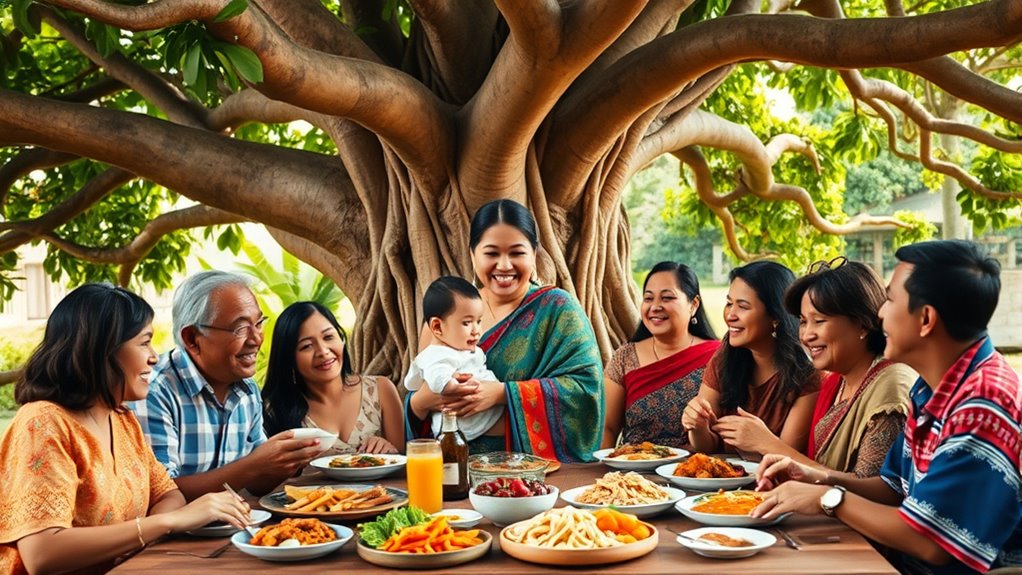Building a family across continents with a Filipina means embracing cultural differences and overcoming language barriers. You’ll navigate complex legal requirements for marriage and understand the importance of maintaining emotional connections through technology. Creating a warm home involves fostering unity, establishing routines, and respecting each other’s backgrounds. As you strengthen your family bonds through shared traditions and open communication, you’ll discover new ways to create lasting memories together. There’s so much more to explore on this journey!
Key Takeaways
- Embracing cultural differences and using multiple languages at home enriched our family life and enhanced communication.
- Regular video calls and messaging apps helped maintain emotional closeness despite the distance between continents.
- Establishing shared traditions and engaging in online games created lasting memories and fostered unity among family members.
- Understanding legal requirements for marriage abroad ensured a smooth process in building our family together.
- Prioritizing face-to-face interactions during visits strengthened our bonds and deepened our connections across borders.
Our Journey: Meeting Across Borders

When you commence a journey to meet loved ones across borders, overcoming language barriers becomes essential.
You’ll find that understanding cultural backgrounds fosters deeper connections, making interactions more meaningful. Digital platforms like social media help bridge the gap, allowing you to connect with family despite the distance.
Sharing experiences, whether through stories or photographs, strengthens your bond, creating a sense of closeness that transcends geographical boundaries.
Be mindful of the geopolitical contexts that can affect your relationships, as they might influence your family dynamics.
Embracing this journey not only enriches your life but also helps you navigate the complexities of cross-border relationships, ensuring that you stay connected with those you cherish most.
Embracing Cultural Differences

Embracing cultural differences enriches family life and fosters deeper connections among members.
You’ll notice how respect for elders, a core Filipino value, strengthens family ties and teaches children about filial piety. By blending cultures, your family’s upbringing becomes a vibrant mix, offering diverse experiences. Additionally, recognizing that trust erosion can occur in relationships due to unmet emotional needs can help you address challenges that arise from cultural differences. Studies indicate higher rates of anxiety and depression in children from homes where emotional needs are unmet, further highlighting the importance of addressing these issues. In fact, understanding the impact of narcissistic behavior can guide families in creating a supportive environment for all members. Couples who prioritize communication often navigate these complex emotional landscapes more effectively.
Using multiple languages at home not only enhances communication but also promotes cultural exchange. Preserving traditions rooted in your heritage will help maintain your family’s identity, especially when living abroad.
Embracing multiple languages at home fosters communication and cultural exchange, preserving your family’s identity across generations.
Filipino culture emphasizes extended family bonds, inviting non-blood relatives into your circle. Engaging with local communities enhances your understanding and adaptability, making cultural integration smoother. Additionally, incorporating pet therapy into family interactions can promote emotional well-being, particularly for those facing cognitive challenges.
Ultimately, celebrating these differences will enrich your family’s shared experiences, creating lasting memories and bonds.
Navigating Legal Requirements

Blending cultures in your family also means understanding the legal requirements for marriage abroad, which can be complex and vary widely depending on the country.
You’ll need specific documentation, like a valid passport, birth certificate, and proof of legal capacity to marry. Some countries might require translations of these documents into the local language. Additionally, it’s essential to be aware of residency requirements specific to the country where you plan to marry, as these can influence your ability to complete the process. In some cases, understanding the divorce process in the country can also inform your legal obligations. Each jurisdiction may have unique grounds for divorce, which could affect your marital rights. In the Philippines, for example, the divorce law remains complex and controversial due to the strong influence of the Catholic Church on public perception.
Marriage laws differ, so check if residency requirements or parental consent are necessary.
After marrying, confirm you register your marriage with local and U.S. authorities. Remember, marriage abroad is recognized in the U.S., but managing dual nationality and potential citizenship for your spouse and children can be tricky. Additionally, it’s important to consider legal guidelines for adoption and guardianship, as they can greatly differ.
Always consult local laws for adoption and guardianship, as they can greatly differ.
Building a Home Together

Building a home together means more than just sharing a physical space; it involves creating a community where everyone feels connected and valued.
You can foster unity by involving the community in the design process, ensuring that everyone’s voice is heard. Using collective financial models makes housing more affordable, while design workshops allow you to create spaces that meet diverse needs. Engaging in Filipino culture can also help strengthen your connection to the community and enrich your shared experiences. Additionally, implementing sustainable building practices not only reduces costs but also benefits the environment and encourages a sense of community engagement. You’ll find that integrating culinary traditions enriches the experience, making it unique. Establishing clear rules and routines can further enhance family dynamics and create a nurturing environment for everyone involved.
By designing shared facilities, you promote social interaction and strengthen bonds. Ultimately, your emotional investment in the project will forge lasting connections within the community.
Together, you’re not just building homes; you’re building a family.
Strengthening Our Family Bonds

While distance can challenge family connections, there are effective ways to strengthen your bonds across continents. Use video calls and messaging apps to stay in touch regularly, sharing photos and videos to maintain that emotional closeness.
Engage in online games together to create shared experiences and foster unity. Acknowledge each family member’s efforts; it makes a difference. Prioritize face-to-face interactions when possible, ensuring meaningful connections aren’t lost in technology.
Establish shared traditions, like family vacations or game nights, to create lasting memories. Celebrate achievements and engage in group activities to enhance unity.
Emphasize open dialogue and empathy to manage conflicts, and involve everyone in decision-making to build confidence and shared values. These practices will fortify your family bonds across the miles.
Frequently Asked Questions
What Are Common Challenges Intercultural Couples Face?
Intercultural couples often face several challenges. You might struggle with language barriers, making communication tricky.
Different cultural styles can lead to misunderstandings, especially when expressing emotions. Family expectations and societal pressures can add stress, while varying financial priorities complicate joint planning.
Legal hurdles, like immigration issues, can create additional strain. Maneuvering these challenges requires patience, open dialogue, and a willingness to understand each other’s backgrounds and perspectives.
How Do Families React to Intercultural Marriages?
They say, “Love knows no boundaries.” However, families often react cautiously to intercultural marriages. You might face resistance due to differing cultural values or expectations, particularly in cultures that prioritize parental approval.
Open communication is essential to bridge these gaps. By respecting traditions and seeking understanding, you can foster acceptance and harmony.
Over time, your family’s involvement can evolve, leading to a richer, more diverse family experience that honors both cultures.
What Tips Help With Language Barriers?
To overcome language barriers, start by setting clear goals for your learning.
Immerse yourself in the language through movies and music, and engage with native speakers. Use apps or online courses to structure your lessons and practice consistently.
Create a supportive environment where you can openly discuss challenges. Celebrate small victories to keep your motivation high, and remember to be patient with yourself as you navigate this exciting journey of language acquisition.
How Can We Celebrate Both Cultures in Our Home?
Imagine your home as a vibrant tapestry, weaving together threads of both cultures. To celebrate both, host joint celebrations that showcase traditional holidays, blending Filipino and other customs.
Incorporate fusion meals during family gatherings, mixing favorite dishes. Share stories about your ancestors, enriching your children’s understanding.
Engage in cultural activities, like visiting ethnic restaurants or role-playing historical figures, to foster an appreciation for diversity while strengthening family bonds.
What Support Networks Exist for Intercultural Families?
For intercultural families, numerous support networks can make a significant difference. You can explore organizations like Intercultural Family Services, which offer culturally competent programs and resources.
Local family support centers provide recreational activities and training, while peer support models connect you with others facing similar challenges.
Additionally, cultural events and social skills groups foster understanding and community engagement, helping you navigate the complexities of blending diverse backgrounds in your family life.
Conclusion
In this tapestry of love, you’ve woven threads from different continents, creating a vibrant masterpiece. Each stitch, a lesson in patience and understanding, binds your hearts closer. As you nurture this garden of family, remember that every bloom represents a shared moment, every thorn a challenge overcome. Together, you’ve built a bridge over oceans, proving that love knows no borders. So, keep tending to this beautiful creation, and watch it flourish for years to come.









